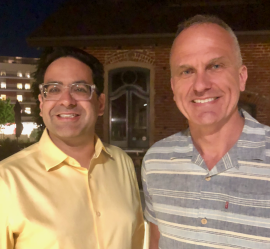Palo Alto, CA — Robert MacLaren, Professor of Ophthalmology at University of Oxford and Fellow of Merton College, gave the inaugural lecture for the Molecular Surgery Program’s Special Grand Rounds.

The Molecular Surgery Program at Beyer’s Eye Institute, under the direction of vitreoretinal surgeon-scientist Vinit Mahajan, Associate Professor of Ophthalmology at Stanford University, was established to improve surgical outcomes and advance new surgical therapies for hard to treat eye diseases.
“Our focus is on identifying and controlling specific molecules to treat eye disease,” explains Mahajan. “The combination of molecular therapies with traditional surgery will allow for extremely precise delivery of novel drugs right to diseased cells where we target diseased molecules. We need to think beyond using surgery as a means of manipulating tissues, but instead as a means of operating at the molecular level.”
The Molecular Surgery Program’s scientist teams are developing gene therapies to fix faulty genes, optimizing cell transplants to replace unhealthy tissue, and using proteomic analyses of liquid biopsies to select the personalized drugs in hard to treat cases. Groundbreaking CRISPR technologies that target molecules surgically have opened up possibilities that surgeons and scientists are just beginning to envision. Mahajan sees molecular surgery as the key to breakthroughs in the safe delivery of small-molecule drugs, antibodies, gene therapies, and cell therapies.
MacLaren, a pioneer in molecular surgery, spoke on “Research into Treating Blindness with Genetic, Electronic, and Robotic Devices.” The lecture highlighted his expertise and visionary research. He touched on basic concepts of retinal gene therapy and how choroideremia is being treated. He explained how patients with advanced vision loss can see again after implanting a subretinal chip while demonstrating the surgical technique on how to implant the chip.
“As we develop new therapies, we also need to update our surgical techniques,” MacLaren said.
He then showed how he uses intraoperative optical coherence tomography to guide the microscopic subretinal injection of a gene therapy vector.
MacLaren also shared a video of him using a robot operating inside the human eye to reduce hand tremor and discussed the potential future applications of this technology,
After giving his talk, MacLaren spent the rest of the day collaborating with professors and students in the department of ophthalmology. In the Mahajan lab, he offered valuable feedback as students presented their research. In Quan Ngyuen’s lab, he participated in a discussion centered on clinical testing for clinical trials.
“We invited MacLaren to Stanford to help promote our educational mission of providing the best possible training for surgeons and researchers in advanced surgical techniques. MacLaren shared a wealth of knowledge that inspired and enriched our scientific community here at Stanford,” emphasized Mahajan.
MacLaren is recognized for advancing the field of gene therapy. He made a successful retinal implant for visual prosthesis and is introducing robot-assisted surgery for ophthalmic operations. In 2016, MacLaren and Dr. Thomas Edwards performed the world's first robot-assisted eye surgery known as the 'R2D2 Trial' at John Radcliffe Hospital in Oxford. Robotic surgery allows surgical operations that are beyond the limits of laser scanners, microscopes, and the human hand. MacLaren also helped to perform the first retinal gene therapy treatment at Moorfields in London.

